Sometimes I have to travel for work, usually to Tel Aviv. Carrying cash is not something I’m good at in the US, and having to get shekels is a hassle.1 My Israeli coworkers always tell me that you really don’t need cash in Israel, so one of the times I went I decided to give it a shot and fly without a parachute.
I landed at Ben Gurion before the sun came up. My guess is it was 5AM. I went through customs (always a coin toss in Israel, maybe it’ll take five minutes, maybe it’ll take two hours) and headed to the taxi area.
Because I arrived so early and couldn’t even check into the hotel until something like 11AM my plan was originally to figure out how to take the train from the airport to Tel Aviv. I’d never done it before and how hard could it be? Unfortunately on Saturday (Shabbat) the trains don’t run.
I started to head outside and a driver approached me.2 He said something in Hebrew, and I said, “Tel Aviv, no3 Shekels” and showed him my credit card. He gestured for me to follow him and I went to his cab.
It’s a surprisingly long drive from Ben Gurion to Tel Aviv. Somehow, during the drive, one of us realized that there had been a misunderstanding and that I didn’t have shekels and all he wanted was shekels. Literally the way we would communicate is that he would type Hebrew into his phone (while driving!) and show me the Google Translate, and I would do the same thing, but English to Hebrew.
I wish I’d taken screenshots of this whole interchange because it was so surreal. We went back and forth; I think he wanted me to go to an ATM, but I said I couldn’t use my credit card on an ATM. Eventually he showed me his phone and it said:
“You could commit a crime.”
I am proud of nearly all of the work I have produced. The one general tip that will allow you to have good results is: practice. I do not mean that you should make a dozen workbenches to build a good workbench, though. Instead, when you encounter a new joint you should practice it in isolation.
Wood is complicated and it’s also not cheap. I often do my practice with Douglas Fir, since it’s the softwood I have on hand and can get from the home center. Due to the winter and summer rings, it’s actually more difficult to work than many hardwoods. It’s good practice, but to some extent it’s pointlessly difficult. If you can, practice the joint you are testing with the wood you plan to use. If you are using something exotic (like my tiny cache of rosewood from broken antique furniture) maybe just wait till you are 100% confident.
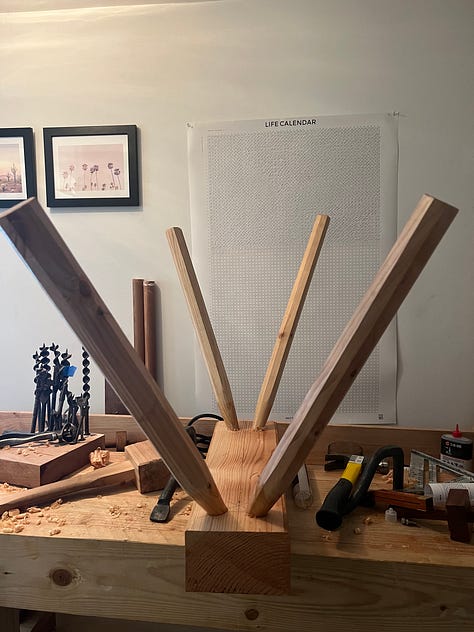
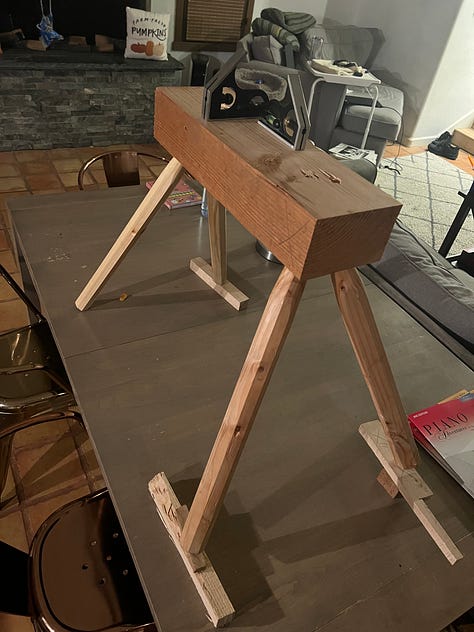
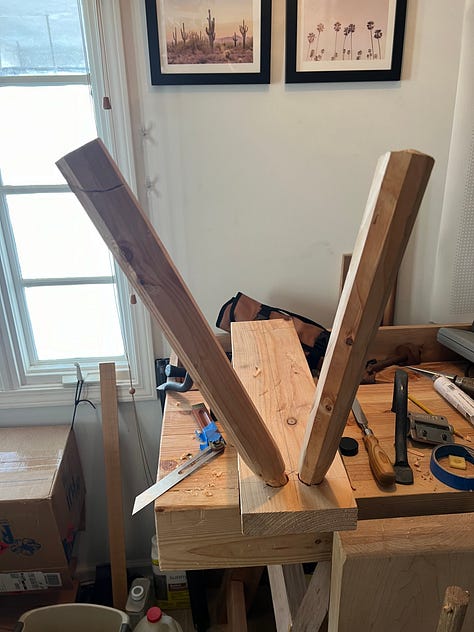
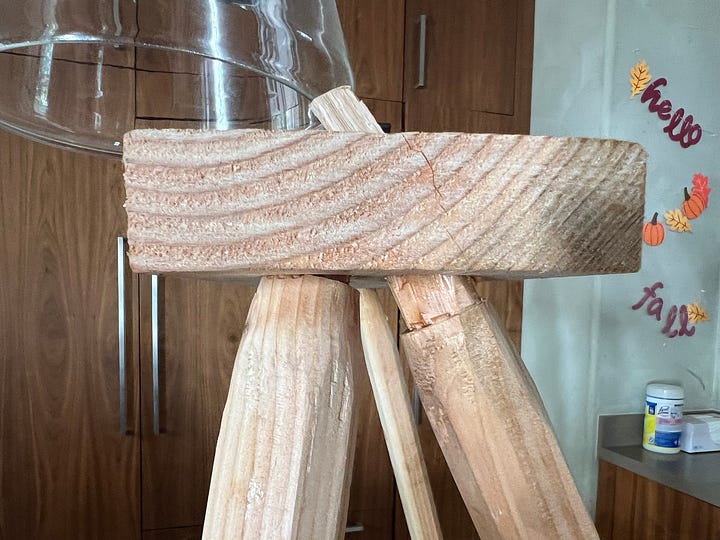
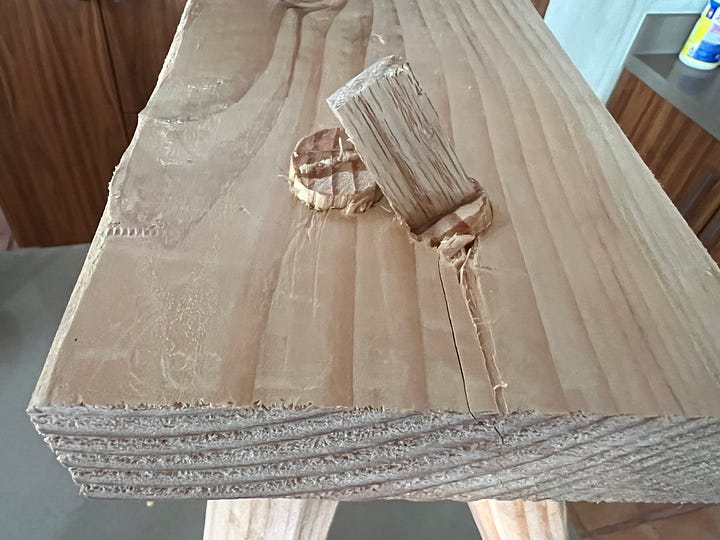
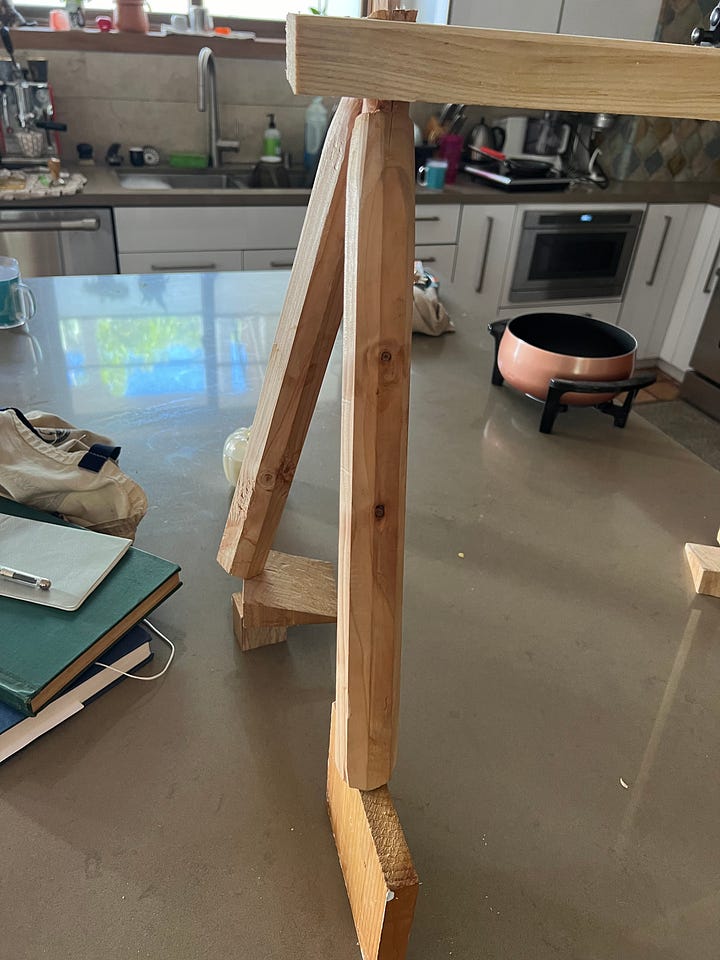
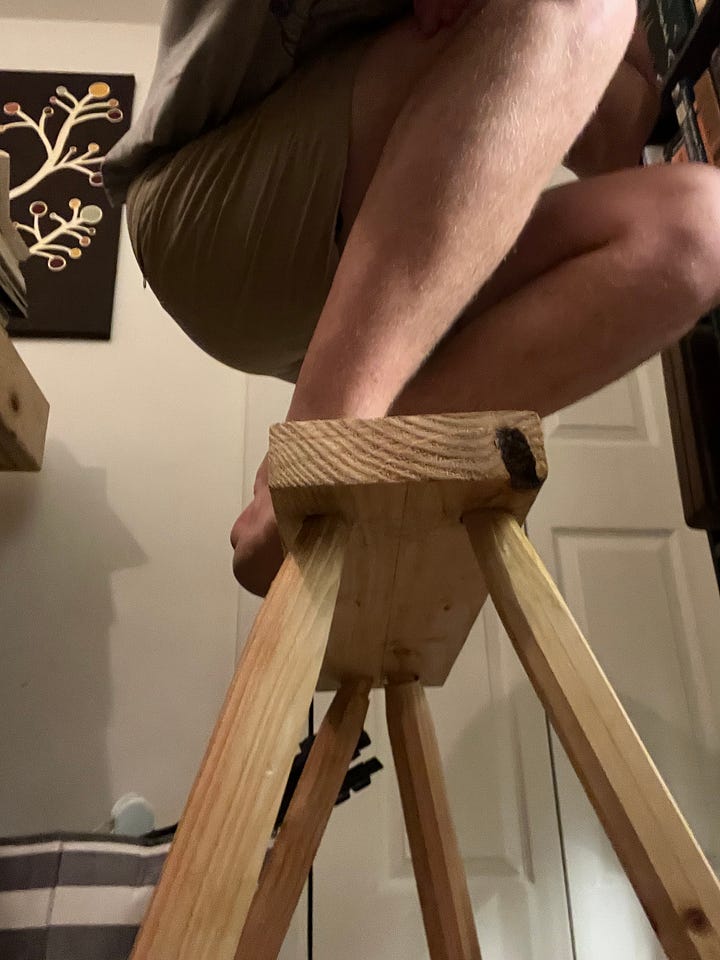
My sawbenches are dual purpose. The primary purpose is to help me to rip pieces comfortably. Their secondary purpose is to give me practice with chair-like forms. I should have made sawbenches much sooner than I did. A frame saw is great, but sawbenches are much more generally useful. Buckets work but the sawbenches are better.
I was intimidated by staked joinery. Staked joinery requires compound angles. Staked joinery requires the use of hard-to-sharpen tools. I tried to build a staked sawbench long before but the angles and legs were all wrong and I got spooked.
After building my bench and my chest, I decided it was time to actually make sawbenches. I started by ripping and then shaving the octagonal legs from some 2x6 dimensional Douglas Fir I had. I made nine legs just in case one of them broke.
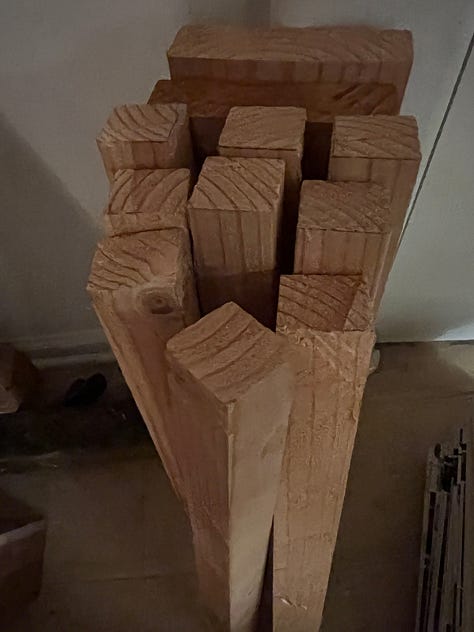
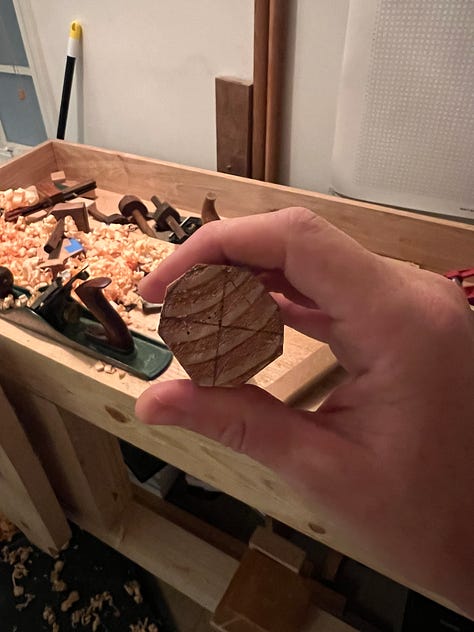
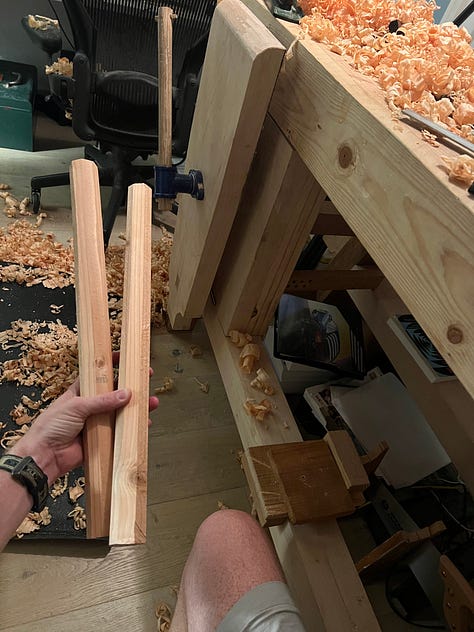
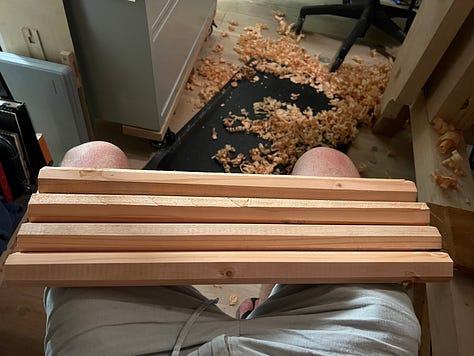
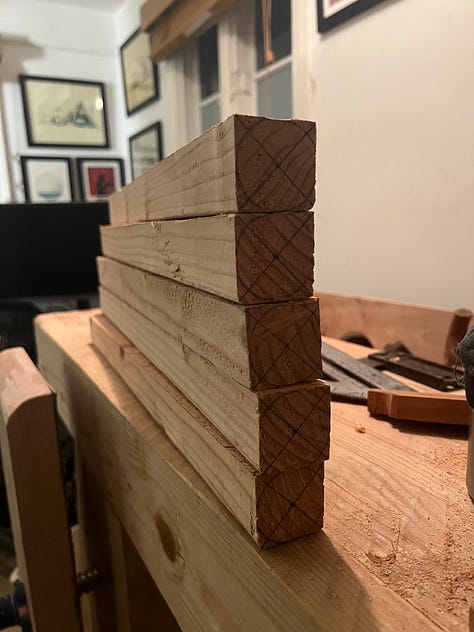
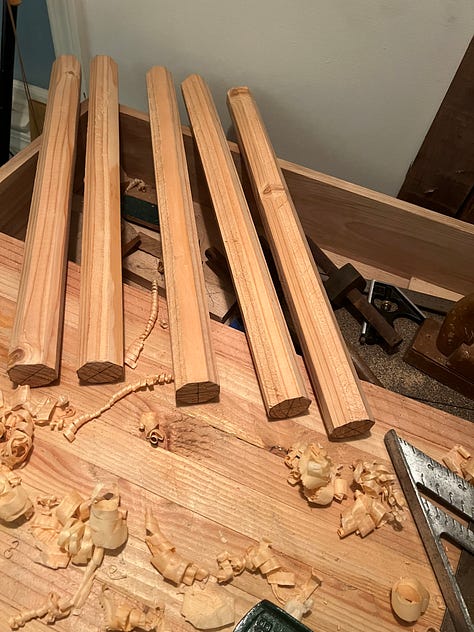
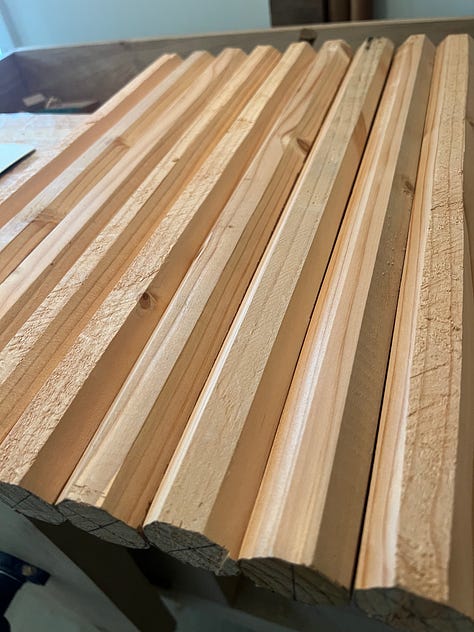
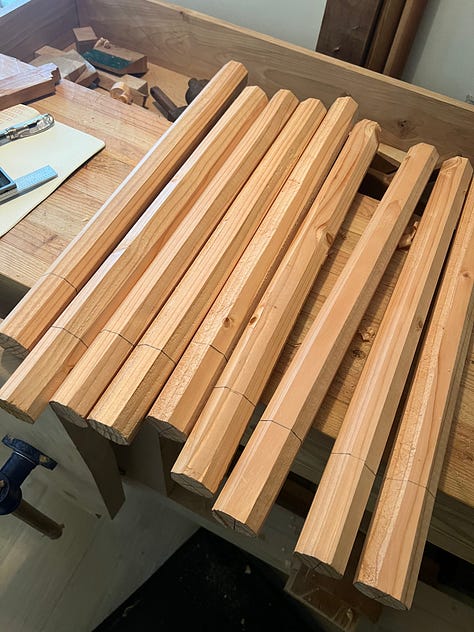
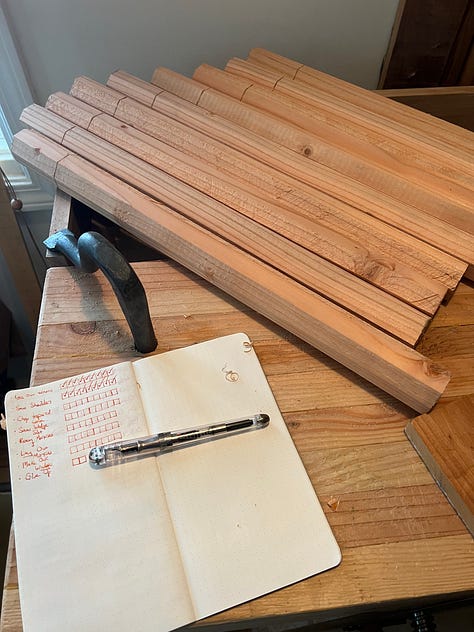
Finally I got started on the real pieces. My plan was to make two sawbenches of the same height (right about at my kneecap.) I used more of the 2x6 that I had. One of the pieces I originally used when restoring my 20 hand planes. It had obvious marks in it from that project. I decided to leave the mark side up as a reminder.
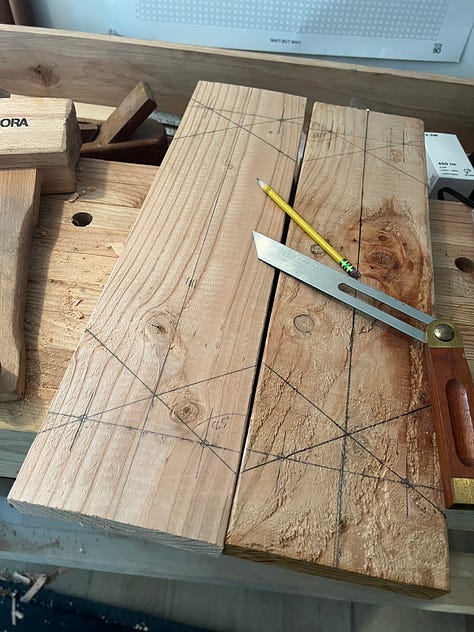
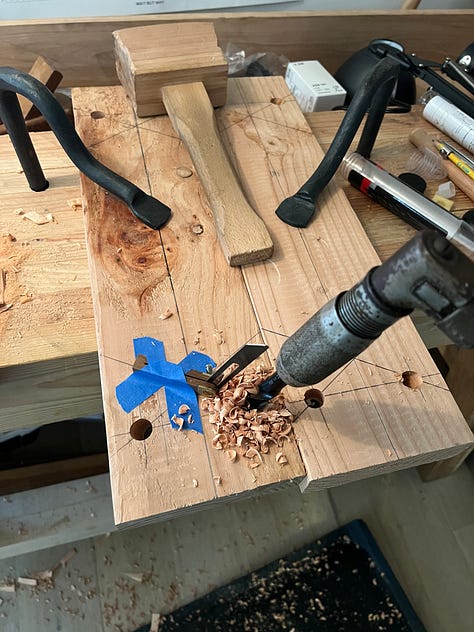
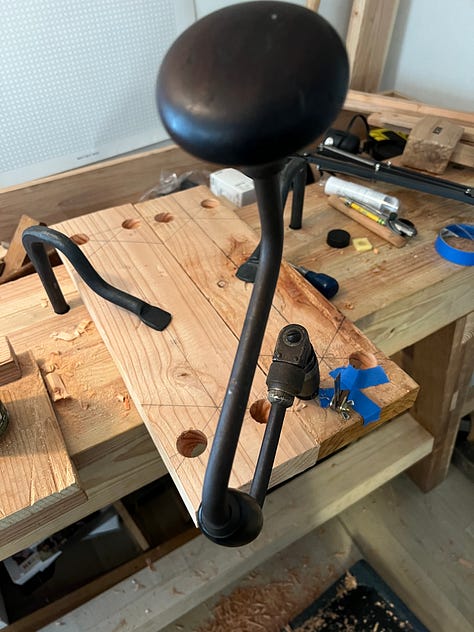
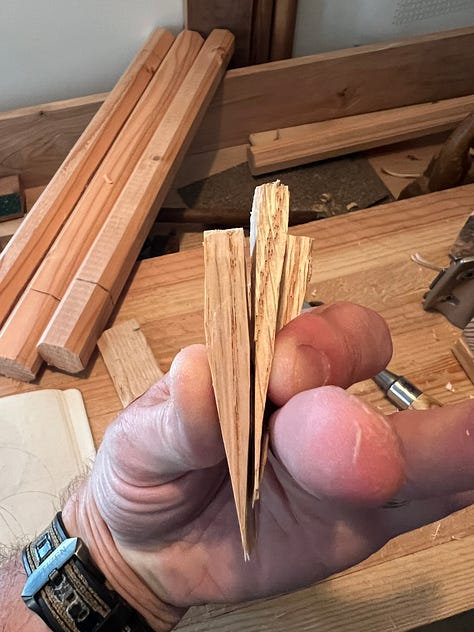
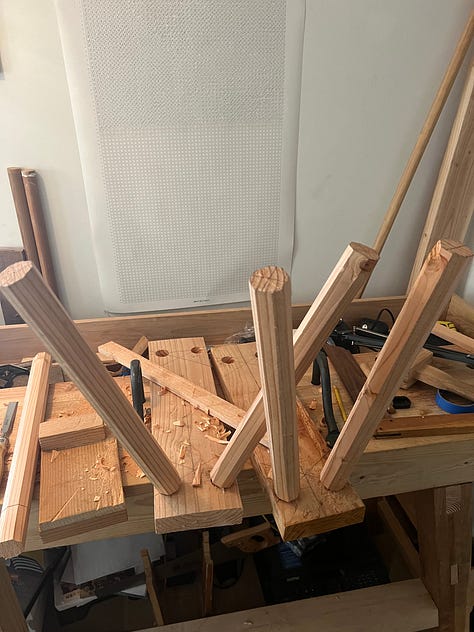
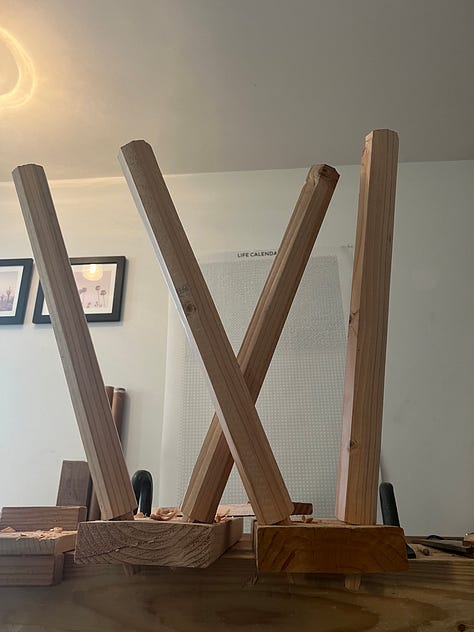
I carefully (though without understand what I was doing) added sightlines to the underside. I bored the mortises and fitted the tenons of the legs I’d made. I sawed slots for wedges in each of the wedges, and made wedges with some scrap red oak.
Finally it was time for glue-up, the most chaotic time for a hand tool woodworker (at least in my experience.) I used hide glue so that if I totally screwed everything up I would be able to rescue the parts and try again. I made the wedges at a stupid backwards angle so they were not as structurally helpful as they should have been.
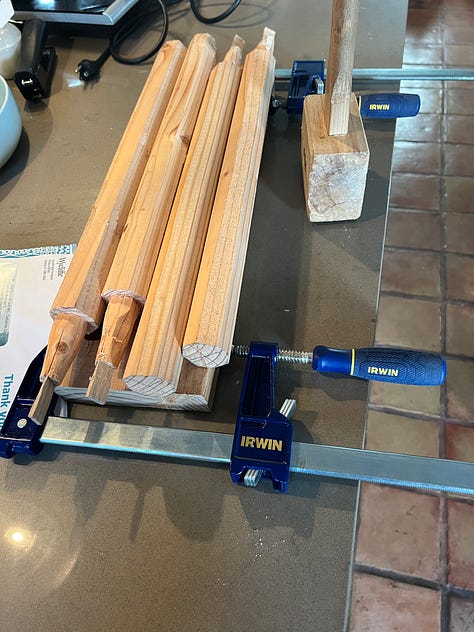
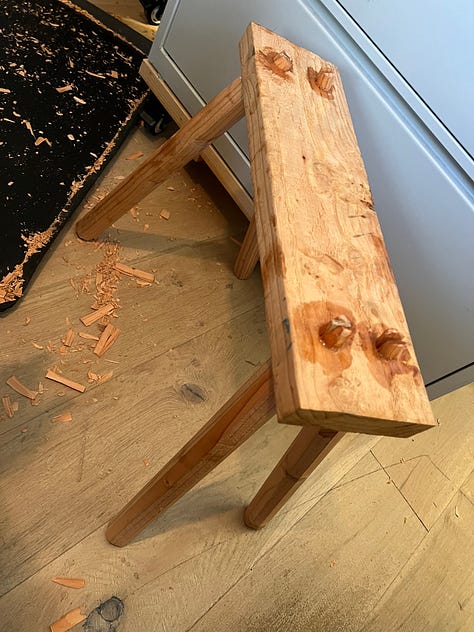
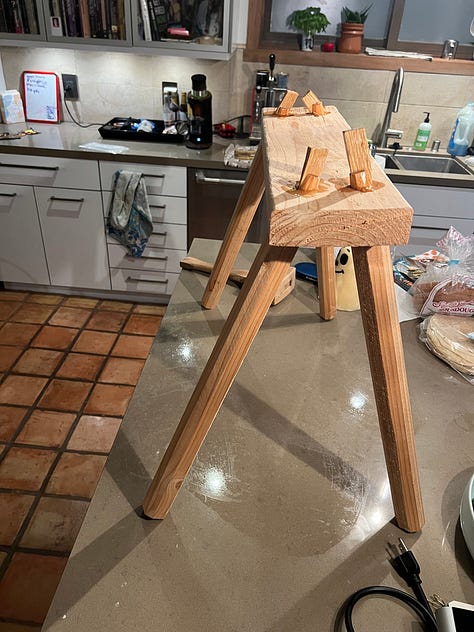
After the chaos of glue up I checked and everything was nice and tight. The next step was to cut the legs to length. I used a couple of spirit levels to get the top level and used a pencil taped to a block to mark the lines I’d saw the feet to. I made a critical mistake here and had the pencil “long” which meant that the lines were not as reliable as they should have been. If I had it to do again (and I do!) I would make a block with bored slots for pencils that would make sure the lines are nice and perfect.
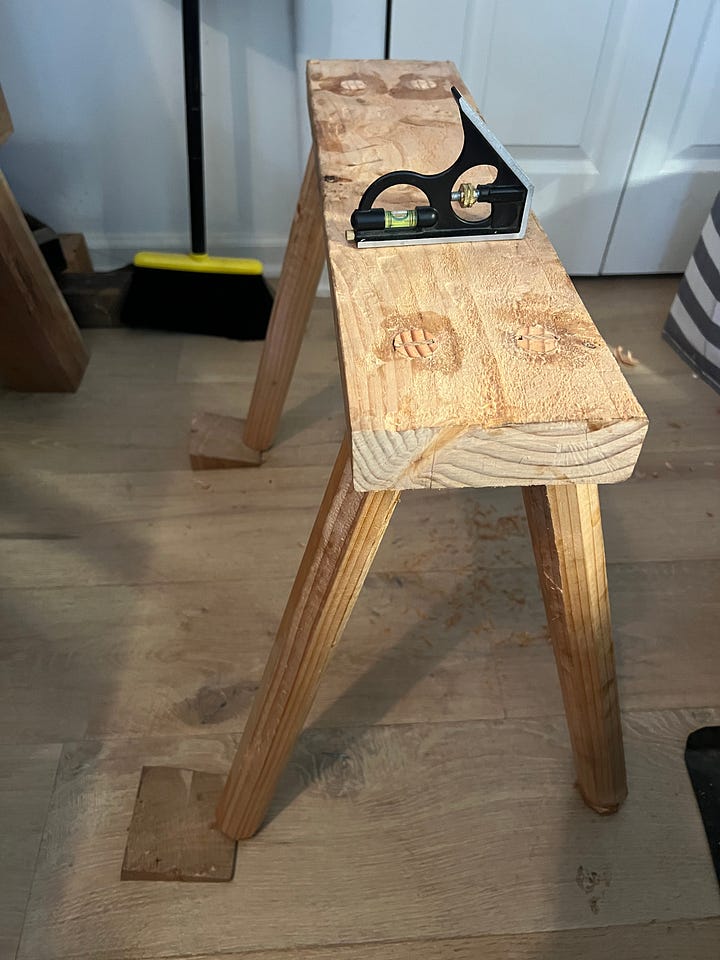
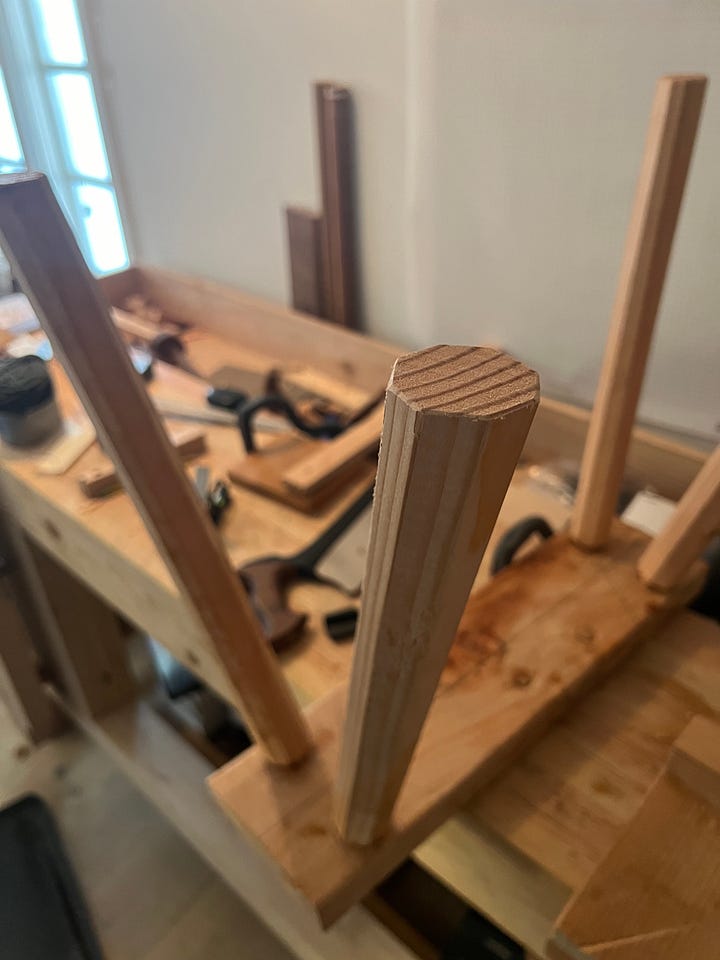
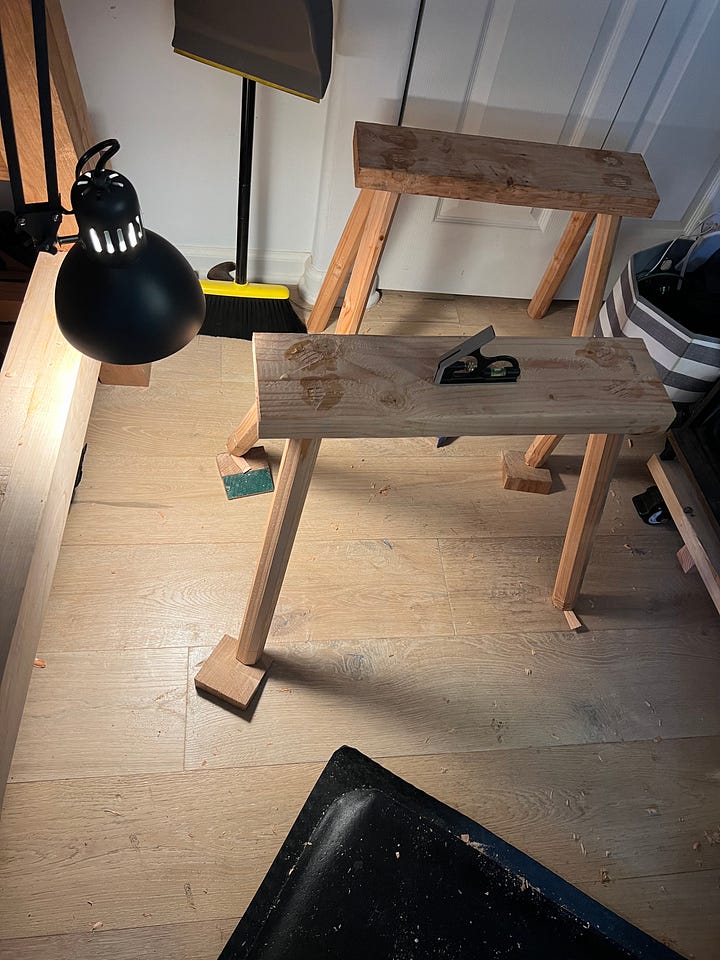
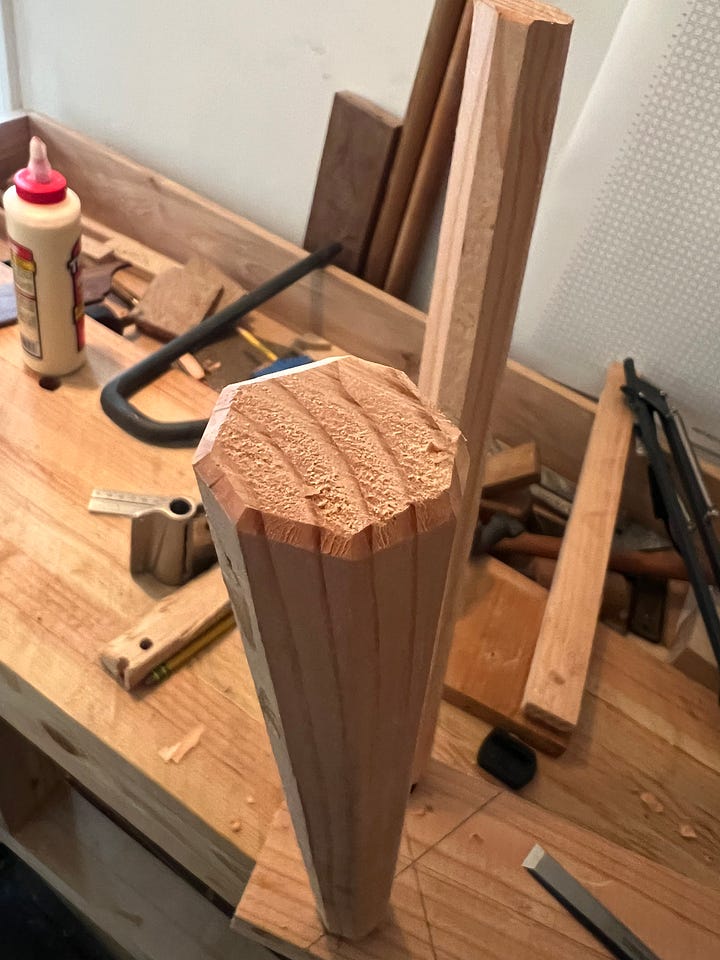
Because the lines are not perfect the sawbenches are slightly wobbly. The legs are soft enough that they splay slightly when I use them and the wobble goes away, but the wobble is a little disturbing nonetheless.
Also, if I had it to do again I would have made legs with fewer knots right through the middle of them. That reduces strength and the wood in knots is really hard to saw through, and I think two of my feet had knots in them.
Despite the mistakes in the sawbenches, I am happy with the results. They are more appropriate to my body than buckets, the work slides around on them less, and sometimes I just sit on them, which you can’t really do with buckets. I do wish that I had successfully made them the same height; maybe I can fix that one day?
I told the taxi driver “I can’t commit a crime” and finally fessed up: I had US dollars. Normally a taxi from Ben Gurion to Tel Aviv is about ₪150, but on Saturday the price goes up some because of the Sabbath and only Arab Israelis will drive. The exchange rate moves around of course, but it’s between three and four ILS to USD, meaning I should have paid $75 at most.
He requested $150. I told him that was not the exchange rate, there’s no way he should get that much. I pushed back pretty hard but he was firm, and eventually I gave up. I gave him $150.
Finally we get to the hotel and I tell him I need a receipt. He’s exasperated but I insist. He takes out his phone and he has a picture of a receipt sitting on a couch. He zooms in on the receipt on his phone, takes my phone, and takes a picture of the screen of his phone. The dates don’t match. I can’t see a price. It’s all in Hebrew.
I could tell a whole story about trying to get cash and having my debit card seized.
This was my biggest mistake, by far.
Oops. Unlike romance languages, “no” does not translate to Hebrew. Their word for no is “Lo.”







Both the taxi drive and the saw benches are intense stories. Did they accept your receipt? I love all the pictures. Glad you didn’t commit a crime...just to pay for a taxi!